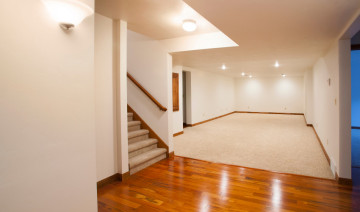{article.name}
What to Consider When Finishing a Basement

- Share this:
- Share on Facebook
- Pin on Pinterest
- Tweet on Twitter
A finished basement can be a valuable addition to home space, but it can also be an overwhelming project to transform a bare basement into a cohesive part of your home. Understanding what to consider when finishing a basement can help you plan the project to create new space you and your family will enjoy for years.
Why Finish a Basement?
There are many reasons to finish a basement, and it is critical to consider how the space will be used before planning the project. Will the space be used to accommodate a growing family? New bedrooms, a play room, or family gathering space may be best. Is an older family member needing their own space? A separate apartment-style space is ideal. New functional spaces can be added into a basement, such as a home office or study space, dedicated theater room, gym, craft room, or even a larger laundry room.
Finishing a basement will increase the home’s livable square footage, ultimately increasing the property’s value. This can be a consideration if the home may be sold in the future, and planning the renovations carefully can maximize that value.
Top 15 Considerations for Finishing a Basement
When finishing a basement, it is critical to consider the project carefully and be sure it is doable. Factors to note for a basement finish include…
- Long-Term Purpose – While you’ve already considered why you want to finish the basement, also note the long-term uses for the space. If it will be a teen space, for example, how can it be used once the teens are grown? Keeping that in mind will help you plan a multi-functional space that will be practical and useful for many years to come.
- Unfinished Layout and Structure – What features are already part of the basement? Is it already plumbed for another bathroom, or are rooms already framed? Is the electrical wiring already in place? Considering what is already in an unfinished basement can help you plan the finishing most efficiently.
- Space Size – Measurements must take into account the space necessary for insulation, framing, walls, and supports. If you want a pool table or gaming area, for example, you will need a larger open space, while a home office or spare guest room can be cozier and more compact.
- Budget – It is important to be very careful with the budget when finishing a basement, as it is very easy to overrun expenses. Consider hidden costs for repairs and upgrades, and think about saving money on do-it-yourself parts of the project versus where it is necessary to hire a professional to be sure the job is done well.
- Building Codes – Before getting too deep into a basement finish, investigate any building codes you will need to meet in the new space. This may regulate ceiling heights, stairway widths, window placement and size, and other features to be sure the space is properly up to code.
- Moisture Levels – Basements are notorious for mold, mildew, leaks, and even floods. Before finishing, the space should be carefully checked for moisture issues, and any problems corrected before new materials are installed. Be sure the space will include proper ventilation after finishing if new problems occur, especially for a new bathroom.
- Safety Tests – Before beginning a basement upgrade, test the space for potentially toxic gasses, including radon and carbon monoxide. If problems are detected, it is critical that they be corrected before renovations begin.
- Stairway – Many stairways leading to a basement can be narrow and dark. Opening up the stairway can make it more welcoming, and there should be adequate light for safe walking on the stairs. Consider handrails and the proper flooring to keep stairs safe and comfortable.
- Soundproofing – While it isn’t seen, the soundproofing in a basement space is critical. This is especially true if the space may be used for teens, gaming, movies, music, or other potentially loud activities, and you don’t want the noise reverberating through the entire house.
- Lighting – Basements are often low on natural light, and adding extra windows can make the space brighter and more enjoyable. Also consider extra lighting options, such as dimmers, sun tubes, or accent lighting for a more creative and well-lit space.
- Flooring – Basement flooring needs to be durable for high use, and also needs to resist moisture that may seep up from the concrete foundation. Choose flooring specially designed for basement spaces for the best results.
- Ceiling Height – Basements often have lower ceilings to leave space for ventilation ducts and wiring leading to the upper part of the house. Choose a ceiling option that will maximize the available height, but will still provide access to the wiring, plumbing, and ductwork for repairs and maintenance if necessary.
- HVAC Equipment – If heating and cooling machinery is in the basement, it’s common to create a small, closet-like room to conceal it. It is important, however, to leave enough space around the equipment so it can be easily accessed for maintenance, repairs, or replacement.
- Storage – Many people use basement space for storage, and if you plan on finishing the basement, you may want to incorporate extra storage space. Leaving one unfinished room is an option, or you can incorporate built-ins as part of the renovation. Finishing a basement is also a good time to declutter and clear out unused, broken, or outdated items.
- Escape Routes – Just as it is important to have escape routes from other rooms in the house, it is also important to have escape routes from a finished basement. Be sure there are multiple ways to leave the basement in case of an emergency, so no one is trapped or left behind.
Finishing a basement is a massive undertaking, but it can have massive benefits for home value and usable space. By considering the project carefully, you can plan for the most efficient options that will create results you and your family will enjoy.
Sign up for our Email List
Stay updated with all our latest posts, products and offers! Just enter your information below.

Comments